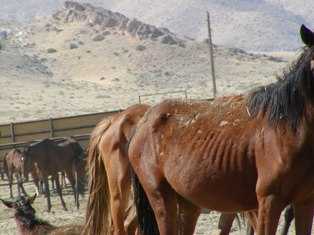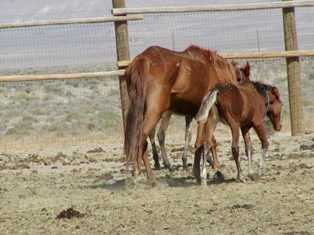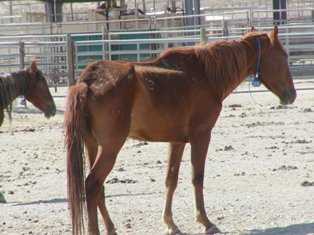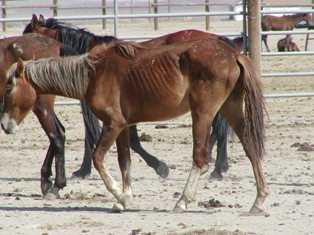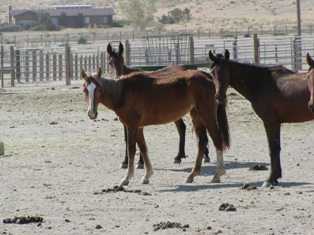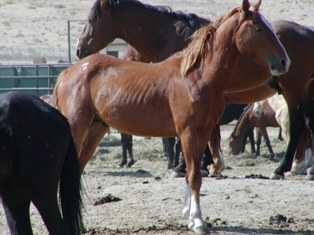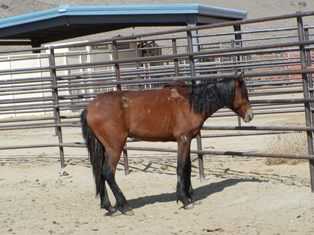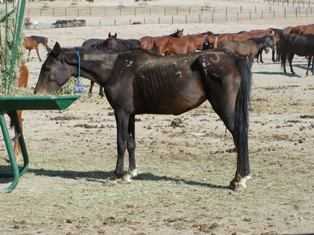Disease runs through weak horse herd
|
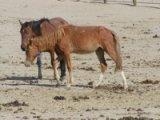
|
|
Story Date: October 5, 2007
Please note: We held off posting this story until we could authenticate the information that we are presenting. Two veterinary (DVM) pathologists, my daughter Cathy on the staff at the University of Oklahoma and Corrine Davis on the staff at Stanford University, assisted with facts, explanations and opinions. Salmonella is part of the environment in Nevada. It can be found in reptiles, some birds and in fecal matter from a variety of animals including horses and cattle. Nevada is the most arid state in the union and we are experiencing a significant drought year. Tom Gribbin from the Virginia Range Wildlife Protection Association and I rode out to the Carson River on September 29th and the river was bone dry. Although a few areas in the state have remained healthy, in countless areas the springs have dried up. Other springs are barely more than seeps. A number of streams are little more than a scattering of vernal pools in low places where what little water that is seeping through sand and gravel can see daylight. Horses often have to paw out seeps to get enough water to drink. Horses walk through fecal matter. All sorts of animals poop near water sources. It doesn't take a rocket scientist to figure out that salmonella is going to be in great supply in many places this year. Salmonella is one of Nature's balancing organisms. When times are hard, salmonella is one of the means by which grazing animals are culled. The weakest die off. The fittest remain to propagate and they remain in fewer numbers which in turn helps the plant communities recover. It's a nasty business and Mother Nature is one mean mother. What is hard to quantify is how many horses die out on the range. The weaker ones are going to drop whether held in a facility or if left out on the range. This form of salmonella causes scours which dehydrates the infected animals and further propagates the bacteria. Dehydrated animals can't camp by the water holes as they have to range to find enough food. Dehydrated animals ranging for food have to have water. One can easily come to the logical conclusion that salmonella is going to kill weaker horses. We see dead horses out on the range. Usually we find a leg here, a skull there, as the coyotes each pull off a piece and drag it away to eat in peace. Sometimes we can match parts to a single animal. Other times things aren't so clear. My point is that in a facility it's easy to count the sick and dead. Out on a remote range it is a lot harder to accurately calculate horse losses. Hundreds of horses die each year on the range due to natural causes and we don't see the carcasses piled up. Nature's cleaning crews take care of the bodies. BLM brought in around 1,000 head from the Jackson Mountains and according to both BLM and private observers the horses were in pretty poor condition. (Please see the representative photos on the right.) BLM put the horses on grass hay which according to both our experience and veterinarians whom we trust is the appropriate feed for "intake" horses. Healthy horses will adapt appropriately to this feed with minimal side effects unless they are significantly debilitated and/or come into the facility with high levels of harmful bacteria in their guts. What we cannot know is how many horses would have died if the entire gather had been left out on the range. It is possible that current range conditions could have produced a cataclysmic die off. Although it is probable that the stronger individuals would have survived on the range, the total number of range casualties could have greatly exceeded the 125 or so head that died from salmonella in the corrals. Horses have a symbiotic relationship with the range. They originally evolved here. One way or another the populations will decline during harsh conditions, either by migrating or by dying off. I suppose the question boils down to whether we let Nature or the BLM regulate the numbers. Due to man made obstacles many horses no longer have the ability to migrate out of an over-stressed range into better grazing areas so that they can remain healthy and so the stressed ranges can recover. Ergo I think we're stuck with human intervention as the solution. The range has to recover in order to support healthy horses and having sick horses competing for shrinking resources and spreading more disease is far from the best solution. For me the argument isn't whether wild herds have to be managed, but that they be managed as an established component of our multiple use policy of our public lands and that such management is based on sound science, follows established laws and is not skewed by political or corporate interests. Based on the generally agreed upon condition of the horses, the Jackson Mountains gather was appropriate under the circumstances and BLM followed appropriate management practices while intaking the horses. Another issue involves foals that had to be separated from their dams. Some foals have been Fostered out to competent and experienced caregivers and there is still capacity available among qualified caregivers should BLM find itself with additional foals that need more personal supervision and/or nursing. Finally, BLM is used to sanitizing its facilities when a problem like this arises. In fact PVC is "emptied" at least once a year for a general sanitizing before fall gathers start and new horses are brought in. Sick horses are not going to be shipped to other facilities and operators such as Cattoors know the importance of sanitizing their transports of fecal matter that could contain high bacterial content. Such is not only the most appropriate veterinary practice, but BLM can't meet its objectives if another salmonella outbreak results from an overly casual approach to dealing with this problem. Contractors like Cattoors gather and haul a lot of privately owned stock. They certainly can't risk getting a reputation of being sloppy and unnecessarily exposing stock to serious diseases so I expect they will follow appropriate sanitizing practices also. The number of people concerned about this salmonella outbreak is worthwhile. This situation illustrates how serious things are out here, especially in those areas where the range has become poor. These horses are tough and in general don't have an easy life, but that's how Nature works- the survival of the fittest. When this issue is resolved BLM should have a good selection of tame and partially tame foals that need permanent homes. We recommend that folks who take foals already have adult horses with which the foals can interact and learn how to be safe, polite horses. I hope anyone who has the ability and skill to help will adopt an animal or two once they are safe to place so that they can end up in good, permanent situations where they won't be stressed and where they can adapt to a caring domestic environment. Willis Lamm |
Typical spring - little more than a trickle.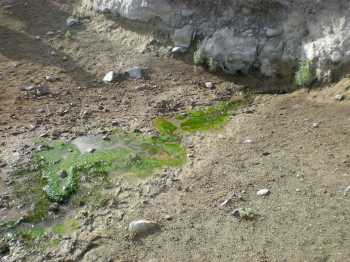
Unedited photos of horses on arrival.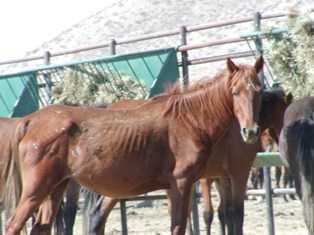
|
